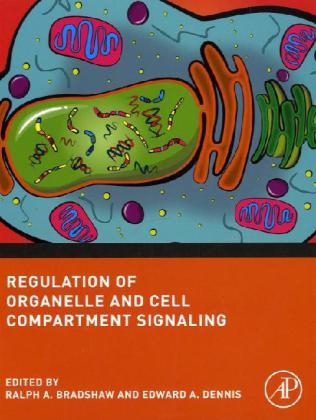Read more
"Cell signaling, which is also often referred to as signal transduction or, in more specialized cases, transmembrane signaling, is the process by which cells communicate with their environment and respond temporally to external cues that they sense there. All cells have the capacity to achieve this to some degree, albeit with a wide variation in purpose, mechanism, and response. At the same time, there is a remarkable degree of similarity over quite a range of species, particularly in the eukaryotic kingdom, and comparative physiology has been a useful tool in the development of this field. The central importance of this general phenomenon (sensing of external stimuli by cells) has been appreciated for a long time, but it has truly become a dominant partof cell and molecular biology research in the past three decades, in part because a description of the dynamic responses of cells to external stimuli is, in essence, a description of the life process itself. This approach lies at the core of the developing fields of proteomics and metabolomics, and its importance to human and animal health is already plainly evident"--Provided by publisher.
List of contents
244 Nuclear Receptor Coactivators
245 Corepressors in Mediating Repression by Nuclear Receptors
246 Steroid Hormone Receptor Signaling
247 Role of COUP-TFII in Congenital Diaphragmatic Hernia
248 Nuclear Receptors in Drosophila melanogaster
249 JAK-STAT Signaling
250 FOXO Transcription Factors: Key Targets of the PI3K-Akt Pathway
251 The Multi-gene Family of Transcription Factor AP-1
252 NF-KB: a Key Integrator of Cell Signaling
253 Transcriptional Regulation via the cAMP Responsive Activator CREB
254 The NFAT Family: Structure, Regulation and Biological Functions
255 Ubiquitination/Proteasome
256 The SMADs
257 Complexity of Stress Signaling
258 Signal Transduction in the Escherichia coli SOS Response
259 Oxidative Stress and Free Radical Signal Transduction
260 Screening Approaches to Identify Genes Required for DNA Double-Strand Break
261 Radiation Responses in Drosophila
262 Double-strand Break Recognition and its Repair by Non-homologous End Joining
263 ATM-Mediated Signaling Defends the Integrity of the Genome
264 Signaling to the p53 Tumor Suppressor through Pathways
265 The p53 Master Regulator and Rules of Engagement with Target Sequences
266 Nuclear and Cytoplasmic Functions of Abl Tyrosine Kinase
267 Radiation-induced Cytoplasmic Signaling
268 The Heat-Shock Response and the Stress of Misfolded Proteins
269 Hypoxia-Mediated Signaling Pathways
270 Regulation of mRNA Turnover by Cellular Stress
271 Oncogenic Stress Responses
272 Ubiquitin and FANC Stress Responses
273 Stress and g -H2AX
274 Translational Control by Amino Acids and Energy
275 Translation Control and Insulin Signaling
276 ER and oxidative stress: Implications in disease
277 Regulation of mRNA Turnover
278 Signaling to Cytoplasmic Polyadenylation and Translation
279 Translational Control in Invertebrate Development
280 The Role of Alternative Splicing During the Cell Cycle and Programmed Cell Death
281 Signaling Pathways that Mediate Translational Control of Ribosome Recruitment
282 The SWI/SNF and RSC Nucleosome Remodeling Complexes
283 ISWI Chromatin Remodeling Complexes
284 The INO80 Chromatin Remodeling Complex
285 Histone Acetylation Complexes
286 Regulation of Histone Deacetylase Activities and Functions by Phosphorylation and
287 Histone Methylation: Chemically Inert But Chromatin Dynamic
288 Histone Phosphorylation: Chromatin Modifications
289 Histone Variants: Signaling or Structural Modules?
290 Silent Chromatin Formation and Regulation in the Yeast Saccharomyces cerevisiae
291 Gene Silencing and Chromatin Modification by Polycomb Complexes
292 Histone Ubiquitination
293 Chromatin-mediated Control of Gene Expression in Innate Immunity and Inflammation
Report
"In order to keep researchers and students up to date on developments in the field, 55 articles were selected and reprinted from the 2008 second edition of the 'Handbook of Cell Signaling' on the transcriptional regulation and the function of nuclei and other subcellular organelles in signaling activities. After an overview, they cover nuclear signaling in transcription, chromatic remodeling, and stress response; signaling to and from intracellular compartments; and cell cycle and cell death signaling. This is one of four volumes of such reprints, called the Cell Signaling Collection."--Reference and Research Book News

